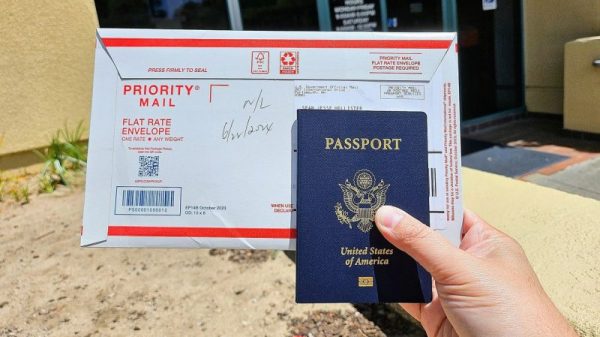Thomas Sibick still can’t say why he did what he did on Jan. 6, 2021.
As Michael Fanone was dragged down the steps of the U.S. Capitol, electroshocked and beaten with flagpoles, Sibick reached down with both hands and pulled off the D.C. police officer’s radio and badge.
“What was my intent? Did I even have an intent?” the 37-year-old from Buffalo wrote in a letter to Judge Amy Berman Jackson last week. “I have grappled with these questions for the better part of two years.”
In U.S. District Court in Washington on Friday, just before being sentenced to 50 months in prison, Sibick turned to Fanone directly and apologized.
“I really am sorry,” he said. “Please forgive me, please.” He called Fanone “the man I aspire to be.” Again, he said, “I still wonder why I did what I did.”
Fanone, speaking earlier in the hearing, called Sibick a “coward and a liar” and “an entitled a–hole.”
Before issuing her sentence, Jackson said she understood why Sibick couldn’t explain himself — “There seems to be no good reason” to attack a trapped, injured police officer. But she bristled at what she called repeated attempts to “spin,” “trivialize,” and “whitewash” his behavior as a thwarted attempt to help Fanone.
“You may persuade other people, you may have persuaded yourself, but you haven’t persuaded me, because it wasn’t true,” Jackson said before sentencing Sibick.
She also said that an alternate explanation Sibick offered, that he was experiencing a psychiatric episode induced by a wrongly prescribed medication, could not fully account for his actions that day.
“This was a deliberate act,” she said. “The videos just don’t show a person who is … wild and out of control.” Other people in the crowd, she noted, were “horrified” by the attack on Fanone and yelled for the assaulters to stop; Sibick did not.
Sibick was part of the mob that formed on the Capitol’s West Terrace, trying to push past a line of police officers guarding that entrance to the building. He got hold of a police riot shield passed through the crowd and posed for a photo with it. He stepped back to clear tear gas out of his eyes just as Fanone was pulled out of the police line and down the Capitol steps.
“In an act of cowardice, [he] stripped me of my badge, the emblem of my duty and what I had dedicated my life to for the past 20 years,” Fanone said in court. “My radio was my lifeline; it was all I had in those moments to call for help. It was taken from me to be used as a trophy.”
Sibick denied that he kept the badge and radio as prizes, but he did not offer an alternative explanation. Nor did he explain why he came to D.C. at all, saying only that he was inspired by Trump’s Dec. 19 tweet that the “Stop the Steal” rally would “be wild” and felt an affinity for the former president because they both attended the same military school. On Jan. 6, Sibick was supposed to be at an internship that would help him become a nursing home administrator.
Sibick was identified by people who saw his pictures from the riot on social media. He then repeatedly dissembled to the FBI, claiming first that he tried to help Fanone but couldn’t reach him, then that he did reach Fanone but accidentally pulled off the badge and radio. He then lied about what happened to the items, saying first that he dropped them immediately, then that he put them in a trash can near the Capitol, and finally that he brought them home to Buffalo and threw them in a dumpster. When agents said they were going to check security video, Sibick admitted he had buried the badge in his backyard. He pleaded guilty in March to one count of assaulting, resisting or impeding police and two counts of theft.
Sibick said in his letter that he was “in a manic state” at the time.
“Since a young age I was in and out of doctors’ offices trying to determine what was wrong with me,” Sibick wrote, documenting a long history of depressive episodes and impulsive behavior. Before Jan. 6, he had been prescribed Adderall for attention-deficit/hyperactivity disorder (ADHD). In the D.C. jail, doctors diagnosed him with bipolar disorder, which can be aggravated by Adderall.
Jackson said Sibick’s mental health problems were “relevant” but “aren’t the full story.” She said she couldn’t blame the Adderall alone, especially since Sibick said he took it only sporadically and was also using cocaine at the time.
During his seven months in the D.C. jail, attorney Stephen Brennwald emphasized, Sibick chose to go into solitary confinement to get away from other Jan. 6 defendants who continued to support Trump and claim that the violent riot was a righteous protest. Brennwald said both he and Sibick had gotten hate mail for talking about intimidation from the other inmates.
“They said I wasn’t a patriot; in fact none of us were patriots, but I was the only one who understood this,” Sibick said in court. He said he is now sober and in mental health treatment. “I don’t think anybody should be judged by their worst mistake,” he said.
“It’s not my role to judge you as a human being at all,” Jackson said. “That’s for a higher power than me.” But judging “the worst thing” he has done, she said, is her job. And she agreed there was some “entitlement” in Sibick’s chafing at the conditions of home confinement and his claims to have suffered severely already.
“I cannot treat this as the biggest calamity in your life when someone else’s life has been ruined,” she said. Fanone spent months recovering from his injuries physically and emotionally. He then left the D.C. police after only a couple months back on duty, saying his continued concern over what happened on Jan. 6 had estranged him from his colleagues.
Assistant U.S. Attorney Kimberly Paschall said that more than 50 D.C. police officers have left the force at least in part because of the events of Jan. 6. “It’s heartbreaking,” she said, “how raw those edges still are.”
In addition to his sentence and the $2,000 fine all Jan. 6 felony defendants pay for the damage to the Capitol, Sibick will owe $5,500 to the D.C. police for the stolen radio.
Thomas Sibick still can’t say why he did what he did on Jan. 6, 2021.
As Michael Fanone was dragged down the steps of the U.S. Capitol, electroshocked and beaten with flagpoles, Sibick reached down with both hands and pulled off the D.C. police officer’s radio and badge.
“What was my intent? Did I even have an intent?” the 37-year-old from Buffalo wrote in a letter to Judge Amy Berman Jackson last week. “I have grappled with these questions for the better part of two years.”
In U.S. District Court in Washington on Friday, just before being sentenced to 50 months in prison, Sibick turned to Fanone directly and apologized.
“I really am sorry,” he said. “Please forgive me, please.” He called Fanone “the man I aspire to be.” Again, he said, “I still wonder why I did what I did.”
Fanone, speaking earlier in the hearing, called Sibick a “coward and a liar” and “an entitled a–hole.”
Before issuing her sentence, Jackson said she understood why Sibick couldn’t explain himself — “There seems to be no good reason” to attack a trapped, injured police officer. But she bristled at what she called repeated attempts to “spin,” “trivialize,” and “whitewash” his behavior as a thwarted attempt to help Fanone.
“You may persuade other people, you may have persuaded yourself, but you haven’t persuaded me, because it wasn’t true,” Jackson said before sentencing Sibick.
She also said that an alternate explanation Sibick offered, that he was experiencing a psychiatric episode induced by a wrongly prescribed medication, could not fully account for his actions that day.
“This was a deliberate act,” she said. “The videos just don’t show a person who is … wild and out of control.” Other people in the crowd, she noted, were “horrified” by the attack on Fanone and yelled for the assaulters to stop; Sibick did not.
Sibick was part of the mob that formed on the Capitol’s West Terrace, trying to push past a line of police officers guarding that entrance to the building. He got hold of a police riot shield passed through the crowd and posed for a photo with it. He stepped back to clear tear gas out of his eyes just as Fanone was pulled out of the police line and down the Capitol steps.
“In an act of cowardice, [he] stripped me of my badge, the emblem of my duty and what I had dedicated my life to for the past 20 years,” Fanone said in court. “My radio was my lifeline; it was all I had in those moments to call for help. It was taken from me to be used as a trophy.”
Sibick denied that he kept the badge and radio as prizes, but he did not offer an alternative explanation. Nor did he explain why he came to D.C. at all, saying only that he was inspired by Trump’s Dec. 19 tweet that the “Stop the Steal” rally would “be wild” and felt an affinity for the former president because they both attended the same military school. On Jan. 6, Sibick was supposed to be at an internship that would help him become a nursing home administrator.
Sibick was identified by people who saw his pictures from the riot on social media. He then repeatedly dissembled to the FBI, claiming first that he tried to help Fanone but couldn’t reach him, then that he did reach Fanone but accidentally pulled off the badge and radio. He then lied about what happened to the items, saying first that he dropped them immediately, then that he put them in a trash can near the Capitol, and finally that he brought them home to Buffalo and threw them in a dumpster. When agents said they were going to check security video, Sibick admitted he had buried the badge in his backyard. He pleaded guilty in March to one count of assaulting, resisting or impeding police and two counts of theft.
Sibick said in his letter that he was “in a manic state” at the time.
“Since a young age I was in and out of doctors’ offices trying to determine what was wrong with me,” Sibick wrote, documenting a long history of depressive episodes and impulsive behavior. Before Jan. 6, he had been prescribed Adderall for attention-deficit/hyperactivity disorder (ADHD). In the D.C. jail, doctors diagnosed him with bipolar disorder, which can be aggravated by Adderall.
Jackson said Sibick’s mental health problems were “relevant” but “aren’t the full story.” She said she couldn’t blame the Adderall alone, especially since Sibick said he took it only sporadically and was also using cocaine at the time.
During his seven months in the D.C. jail, attorney Stephen Brennwald emphasized, Sibick chose to go into solitary confinement to get away from other Jan. 6 defendants who continued to support Trump and claim that the violent riot was a righteous protest. Brennwald said both he and Sibick had gotten hate mail for talking about intimidation from the other inmates.
“They said I wasn’t a patriot; in fact none of us were patriots, but I was the only one who understood this,” Sibick said in court. He said he is now sober and in mental health treatment. “I don’t think anybody should be judged by their worst mistake,” he said.
“It’s not my role to judge you as a human being at all,” Jackson said. “That’s for a higher power than me.” But judging “the worst thing” he has done, she said, is her job. And she agreed there was some “entitlement” in Sibick’s chafing at the conditions of home confinement and his claims to have suffered severely already.
“I cannot treat this as the biggest calamity in your life when someone else’s life has been ruined,” she said. Fanone spent months recovering from his injuries physically and emotionally. He then left the D.C. police after only a couple months back on duty, saying his continued concern over what happened on Jan. 6 had estranged him from his colleagues.
Assistant U.S. Attorney Kimberly Paschall said that more than 50 D.C. police officers have left the force at least in part because of the events of Jan. 6. “It’s heartbreaking,” she said, “how raw those edges still are.”
In addition to his sentence and the $2,000 fine all Jan. 6 felony defendants pay for the damage to the Capitol, Sibick will owe $5,500 to the D.C. police for the stolen radio.























